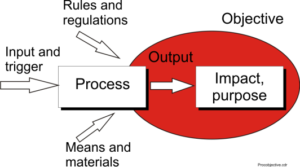ISO19011 defines the objective of system audits a.o. as ‘evaluation of effectiveness of management system in meeting its specified objectives’. I find that people use this definition, but have different perceptions of what constitutes an objective or what is effective. So what do these words mean in practical, unambiguous terms?
First let’s take a look at objective. I define objective as the combination of a desired result and its envisioned impact, in other words a result that will enable clients to undertake something or a result which will create a better situation.
 Using the input-output above diagram gives us the syntax to formulate an objective:
Using the input-output above diagram gives us the syntax to formulate an objective:
We <PROCESS, verb> a <RESULT, noun, finished tense> that enables <CLIENT> to <IMPACT, verb>.
For example; my good design enables you to produce a great product or because I took care of good lighting in the street you can safely walk home in the night.
In the case of a lengthy supply chain we may speak of direct or short-term and indirect or long-term impact. As a supplier our first concern is whether our direct client can work with our result, but the impact on the final beneficiary of the chain might be what gives us a true sense of purpose in our jobs.
So how about effectiveness? To me, effectiveness is always One Step Beyond. Effective processes produce planned results in time and according to specification. Effective results enable clients to undertake or experience what they need to. In this way effectiveness bridges interfaces, from in the box (process) via the edge (result) to out of the box (client use of result).
I propose a hierarchy, effectiveness is the raison d’être for systems or organizations, they get (to keep) their raison d’être by showing results and they need a system to produce those. Always first look at effectiveness.
Photo by Johan Godínez on Unsplash
This blog was published earlier on April 16, 2012



